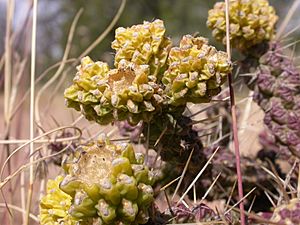Cylindropuntia whipplei facts for kids
Quick facts for kids Cylindropuntia whipplei |
|
|---|---|
 |
|
| Scientific classification | |
| Genus: |
Cylindropuntia
|
| Species: |
whipplei
|
Cylindropuntia whipplei (also known as Whipple cholla) is a type of cactus. It belongs to the cactus family, called Cactaceae. This plant is known for its interesting look and how it has been used by people for a long time.
Contents
What is Whipple Cholla?
The Whipple cholla is a succulent plant, meaning it stores water in its stems. It has a unique shape, with many branches that look like chains. These branches are covered in sharp spines. The plant can grow to be about 3 to 6 feet tall.
Where Does It Grow?
This cactus is native to the Southwestern United States. You can find it in states like Arizona, Colorado, Nevada, New Mexico, and Utah. It usually grows in dry, desert areas. It likes rocky slopes and sandy plains.
Flowers and Fruit
The Whipple cholla produces beautiful flowers. They are usually yellow or greenish-yellow. These flowers bloom in the spring or early summer. After the flowers, the plant grows small, round fruits. These fruits are often yellow or reddish.
How People Use Whipple Cholla
Native American tribes have used the Whipple cholla for centuries. They found many ways to use different parts of the plant.
Food Source
The Zuni people are one tribe that used the fruit of the Whipple cholla. They would carefully remove the sharp spines from the fruit. Then, they would dry the fruit to save it for winter. Dried fruit could also be ground into a flour. This flour was mixed with ground corn meal. They would then make a mush from this mixture. Fresh fruits that didn't have many spines were eaten raw or cooked in stews.
Other Uses
Besides food, parts of the cholla cactus were used for other things. The tough stems could be used for building or making tools. Some parts might have also been used in traditional medicines.
Protecting the Whipple Cholla
Like many desert plants, the Whipple cholla is important to its ecosystem. It provides food and shelter for desert animals. It is also a key part of the natural beauty of the Southwest. Protecting these plants helps keep the desert healthy.
See also

- In Spanish: Cylindropuntia whipplei para niños

